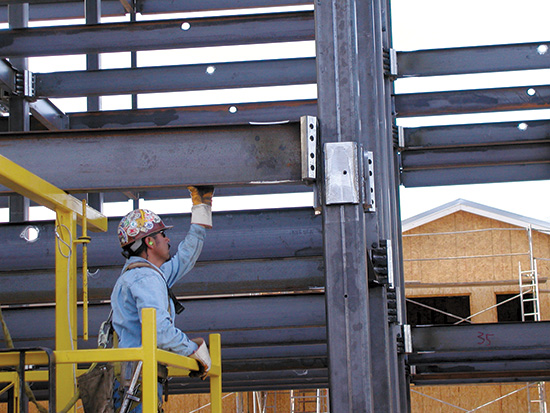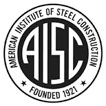Achieving Higher Quality in High-Density Residential: the Strengths of Structural Steel
Modular framing systems. Architects gain economy in design through repetitive floor layouts on stacked floor plates. It is often commonplace in apartment and condominium design to take advantage of repetition by creating typical details, fewer drawings, and a building which owners can easily market with standard rates to future occupants. Repetitive, modular design is most efficient with modular production. Compared to concrete- and wood-framed structures, modular steel framing has achieved cost savings due to its lightweight advantage, reduced material costs, and speed of erection.
Modular connections. Another innovative approach is a modular system based on prefabricated moment connections. With structural steel, the speed of erection can be further increased by simplifying the assembly process in the field. While mainly used in high seismic areas, these modular moment connections may also be applied in zones not governed by seismic activity. A bolted configuration is less labor intensive and more economical than the welding process. The process in the field is a simple assembly from a kit of parts. This method of framing is 35 to 45 percent faster than wood frame residential construction and is also recognized for speed superior to concrete construction.

Photo courtesy of ConXTech®
ConXTech® is a solution for fast erection with modular connections that are lowered, locked into place, and then bolted. The construction sequence takes less than half the time required for alternative conventional systems.
Strong Design Lasts Long
Structural steel systems exhibit a lasting quality which allows for infinite possibilities in the design of apartment and condominium buildings for the present and future. Each site, program, and design intent of a building is unique. Determining the best structural solution for a project takes into account multiple aspects of a project. The material strengths and weaknesses, availability of resources, construction schedule, and sequence of operations are all vital to determining the best structural system. The construction schedule and labor typically are the longest and most costly portions of the building process. Architects must plan for efficient structural systems which reduce time and labor in the field as well as bring the owner value in the short term and long term. Advances in structural steel systems are depicted in the endless span options, speed of erection, innovative technologies, and ability to endure the tests of time and adapt easily to future uses. For the apartment and condominium market, structural steel has great advantages over other material solutions.
Endnotes
- World Steel Recycling in Figures 2009-2013, Bureau of International Recycling (BR), 2014
- 2013 Annual Statistical Report, American Iron and Steel Institute
- Seillie, Ignasius F. and John D. Hooper. Steel plate Shear Walls: practical design and construction. Modern Steel Construction. April 2005. Online.
 |
The American Institute of Steel Construction is a not-for-profit technical institute and trade association representing the structural steel industry. AISC provides technical assistance and complimentary conceptual solutions to architects, engineers, code officials, and educators to promote better, safer, and more economical buildings, bridges, and other structures framed with structural steel. www.aisc.org |








